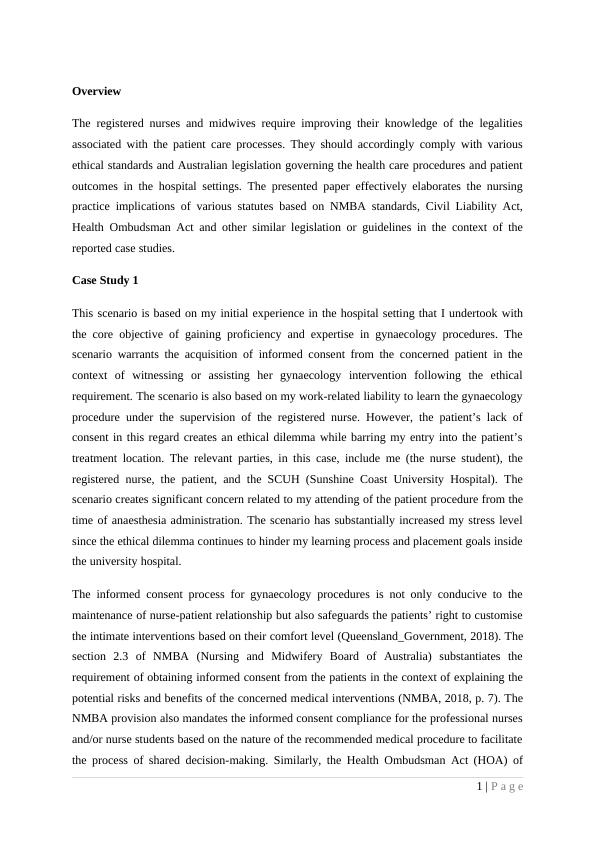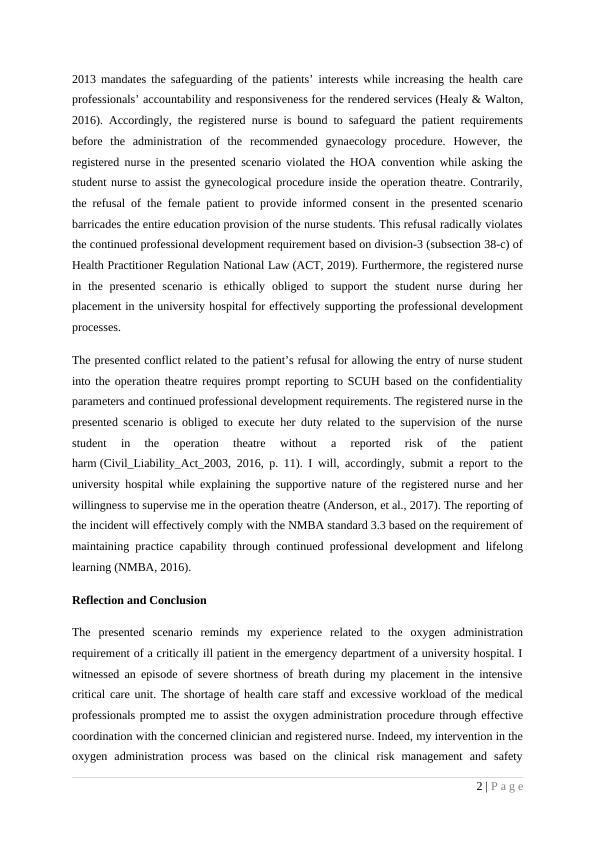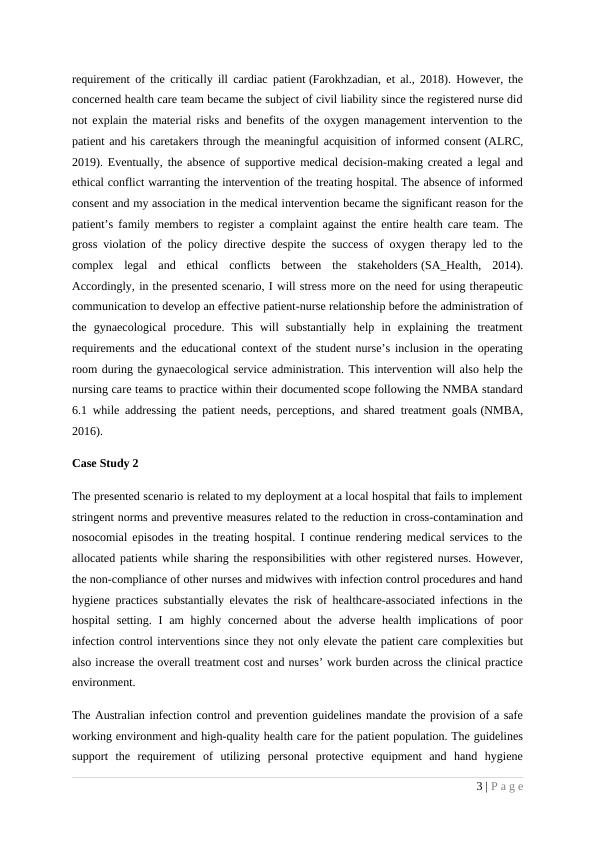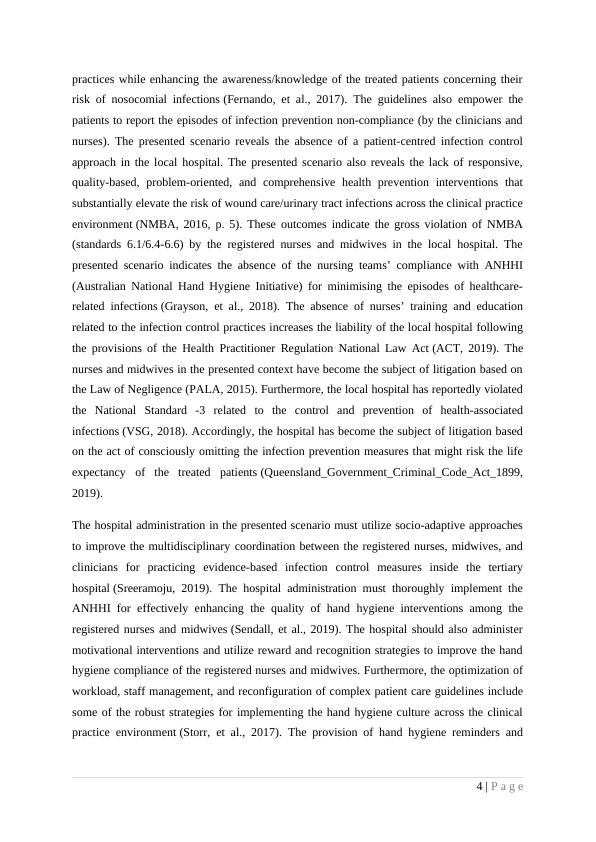Overview Registered Nurses Case Study 2022
Added on 2022-10-13
11 Pages3626 Words25 Views
Overview
The registered nurses and midwives require improving their knowledge of the legalities
associated with the patient care processes. They should accordingly comply with various
ethical standards and Australian legislation governing the health care procedures and patient
outcomes in the hospital settings. The presented paper effectively elaborates the nursing
practice implications of various statutes based on NMBA standards, Civil Liability Act,
Health Ombudsman Act and other similar legislation or guidelines in the context of the
reported case studies.
Case Study 1
This scenario is based on my initial experience in the hospital setting that I undertook with
the core objective of gaining proficiency and expertise in gynaecology procedures. The
scenario warrants the acquisition of informed consent from the concerned patient in the
context of witnessing or assisting her gynaecology intervention following the ethical
requirement. The scenario is also based on my work-related liability to learn the gynaecology
procedure under the supervision of the registered nurse. However, the patient’s lack of
consent in this regard creates an ethical dilemma while barring my entry into the patient’s
treatment location. The relevant parties, in this case, include me (the nurse student), the
registered nurse, the patient, and the SCUH (Sunshine Coast University Hospital). The
scenario creates significant concern related to my attending of the patient procedure from the
time of anaesthesia administration. The scenario has substantially increased my stress level
since the ethical dilemma continues to hinder my learning process and placement goals inside
the university hospital.
The informed consent process for gynaecology procedures is not only conducive to the
maintenance of nurse-patient relationship but also safeguards the patients’ right to customise
the intimate interventions based on their comfort level (Queensland_Government, 2018). The
section 2.3 of NMBA (Nursing and Midwifery Board of Australia) substantiates the
requirement of obtaining informed consent from the patients in the context of explaining the
potential risks and benefits of the concerned medical interventions (NMBA, 2018, p. 7). The
NMBA provision also mandates the informed consent compliance for the professional nurses
and/or nurse students based on the nature of the recommended medical procedure to facilitate
the process of shared decision-making. Similarly, the Health Ombudsman Act (HOA) of
1 | P a g e
The registered nurses and midwives require improving their knowledge of the legalities
associated with the patient care processes. They should accordingly comply with various
ethical standards and Australian legislation governing the health care procedures and patient
outcomes in the hospital settings. The presented paper effectively elaborates the nursing
practice implications of various statutes based on NMBA standards, Civil Liability Act,
Health Ombudsman Act and other similar legislation or guidelines in the context of the
reported case studies.
Case Study 1
This scenario is based on my initial experience in the hospital setting that I undertook with
the core objective of gaining proficiency and expertise in gynaecology procedures. The
scenario warrants the acquisition of informed consent from the concerned patient in the
context of witnessing or assisting her gynaecology intervention following the ethical
requirement. The scenario is also based on my work-related liability to learn the gynaecology
procedure under the supervision of the registered nurse. However, the patient’s lack of
consent in this regard creates an ethical dilemma while barring my entry into the patient’s
treatment location. The relevant parties, in this case, include me (the nurse student), the
registered nurse, the patient, and the SCUH (Sunshine Coast University Hospital). The
scenario creates significant concern related to my attending of the patient procedure from the
time of anaesthesia administration. The scenario has substantially increased my stress level
since the ethical dilemma continues to hinder my learning process and placement goals inside
the university hospital.
The informed consent process for gynaecology procedures is not only conducive to the
maintenance of nurse-patient relationship but also safeguards the patients’ right to customise
the intimate interventions based on their comfort level (Queensland_Government, 2018). The
section 2.3 of NMBA (Nursing and Midwifery Board of Australia) substantiates the
requirement of obtaining informed consent from the patients in the context of explaining the
potential risks and benefits of the concerned medical interventions (NMBA, 2018, p. 7). The
NMBA provision also mandates the informed consent compliance for the professional nurses
and/or nurse students based on the nature of the recommended medical procedure to facilitate
the process of shared decision-making. Similarly, the Health Ombudsman Act (HOA) of
1 | P a g e

2013 mandates the safeguarding of the patients’ interests while increasing the health care
professionals’ accountability and responsiveness for the rendered services (Healy & Walton,
2016). Accordingly, the registered nurse is bound to safeguard the patient requirements
before the administration of the recommended gynaecology procedure. However, the
registered nurse in the presented scenario violated the HOA convention while asking the
student nurse to assist the gynecological procedure inside the operation theatre. Contrarily,
the refusal of the female patient to provide informed consent in the presented scenario
barricades the entire education provision of the nurse students. This refusal radically violates
the continued professional development requirement based on division-3 (subsection 38-c) of
Health Practitioner Regulation National Law (ACT, 2019). Furthermore, the registered nurse
in the presented scenario is ethically obliged to support the student nurse during her
placement in the university hospital for effectively supporting the professional development
processes.
The presented conflict related to the patient’s refusal for allowing the entry of nurse student
into the operation theatre requires prompt reporting to SCUH based on the confidentiality
parameters and continued professional development requirements. The registered nurse in the
presented scenario is obliged to execute her duty related to the supervision of the nurse
student in the operation theatre without a reported risk of the patient
harm (Civil_Liability_Act_2003, 2016, p. 11). I will, accordingly, submit a report to the
university hospital while explaining the supportive nature of the registered nurse and her
willingness to supervise me in the operation theatre (Anderson, et al., 2017). The reporting of
the incident will effectively comply with the NMBA standard 3.3 based on the requirement of
maintaining practice capability through continued professional development and lifelong
learning (NMBA, 2016).
Reflection and Conclusion
The presented scenario reminds my experience related to the oxygen administration
requirement of a critically ill patient in the emergency department of a university hospital. I
witnessed an episode of severe shortness of breath during my placement in the intensive
critical care unit. The shortage of health care staff and excessive workload of the medical
professionals prompted me to assist the oxygen administration procedure through effective
coordination with the concerned clinician and registered nurse. Indeed, my intervention in the
oxygen administration process was based on the clinical risk management and safety
2 | P a g e
professionals’ accountability and responsiveness for the rendered services (Healy & Walton,
2016). Accordingly, the registered nurse is bound to safeguard the patient requirements
before the administration of the recommended gynaecology procedure. However, the
registered nurse in the presented scenario violated the HOA convention while asking the
student nurse to assist the gynecological procedure inside the operation theatre. Contrarily,
the refusal of the female patient to provide informed consent in the presented scenario
barricades the entire education provision of the nurse students. This refusal radically violates
the continued professional development requirement based on division-3 (subsection 38-c) of
Health Practitioner Regulation National Law (ACT, 2019). Furthermore, the registered nurse
in the presented scenario is ethically obliged to support the student nurse during her
placement in the university hospital for effectively supporting the professional development
processes.
The presented conflict related to the patient’s refusal for allowing the entry of nurse student
into the operation theatre requires prompt reporting to SCUH based on the confidentiality
parameters and continued professional development requirements. The registered nurse in the
presented scenario is obliged to execute her duty related to the supervision of the nurse
student in the operation theatre without a reported risk of the patient
harm (Civil_Liability_Act_2003, 2016, p. 11). I will, accordingly, submit a report to the
university hospital while explaining the supportive nature of the registered nurse and her
willingness to supervise me in the operation theatre (Anderson, et al., 2017). The reporting of
the incident will effectively comply with the NMBA standard 3.3 based on the requirement of
maintaining practice capability through continued professional development and lifelong
learning (NMBA, 2016).
Reflection and Conclusion
The presented scenario reminds my experience related to the oxygen administration
requirement of a critically ill patient in the emergency department of a university hospital. I
witnessed an episode of severe shortness of breath during my placement in the intensive
critical care unit. The shortage of health care staff and excessive workload of the medical
professionals prompted me to assist the oxygen administration procedure through effective
coordination with the concerned clinician and registered nurse. Indeed, my intervention in the
oxygen administration process was based on the clinical risk management and safety
2 | P a g e

requirement of the critically ill cardiac patient (Farokhzadian, et al., 2018). However, the
concerned health care team became the subject of civil liability since the registered nurse did
not explain the material risks and benefits of the oxygen management intervention to the
patient and his caretakers through the meaningful acquisition of informed consent (ALRC,
2019). Eventually, the absence of supportive medical decision-making created a legal and
ethical conflict warranting the intervention of the treating hospital. The absence of informed
consent and my association in the medical intervention became the significant reason for the
patient’s family members to register a complaint against the entire health care team. The
gross violation of the policy directive despite the success of oxygen therapy led to the
complex legal and ethical conflicts between the stakeholders (SA_Health, 2014).
Accordingly, in the presented scenario, I will stress more on the need for using therapeutic
communication to develop an effective patient-nurse relationship before the administration of
the gynaecological procedure. This will substantially help in explaining the treatment
requirements and the educational context of the student nurse’s inclusion in the operating
room during the gynaecological service administration. This intervention will also help the
nursing care teams to practice within their documented scope following the NMBA standard
6.1 while addressing the patient needs, perceptions, and shared treatment goals (NMBA,
2016).
Case Study 2
The presented scenario is related to my deployment at a local hospital that fails to implement
stringent norms and preventive measures related to the reduction in cross-contamination and
nosocomial episodes in the treating hospital. I continue rendering medical services to the
allocated patients while sharing the responsibilities with other registered nurses. However,
the non-compliance of other nurses and midwives with infection control procedures and hand
hygiene practices substantially elevates the risk of healthcare-associated infections in the
hospital setting. I am highly concerned about the adverse health implications of poor
infection control interventions since they not only elevate the patient care complexities but
also increase the overall treatment cost and nurses’ work burden across the clinical practice
environment.
The Australian infection control and prevention guidelines mandate the provision of a safe
working environment and high-quality health care for the patient population. The guidelines
support the requirement of utilizing personal protective equipment and hand hygiene
3 | P a g e
concerned health care team became the subject of civil liability since the registered nurse did
not explain the material risks and benefits of the oxygen management intervention to the
patient and his caretakers through the meaningful acquisition of informed consent (ALRC,
2019). Eventually, the absence of supportive medical decision-making created a legal and
ethical conflict warranting the intervention of the treating hospital. The absence of informed
consent and my association in the medical intervention became the significant reason for the
patient’s family members to register a complaint against the entire health care team. The
gross violation of the policy directive despite the success of oxygen therapy led to the
complex legal and ethical conflicts between the stakeholders (SA_Health, 2014).
Accordingly, in the presented scenario, I will stress more on the need for using therapeutic
communication to develop an effective patient-nurse relationship before the administration of
the gynaecological procedure. This will substantially help in explaining the treatment
requirements and the educational context of the student nurse’s inclusion in the operating
room during the gynaecological service administration. This intervention will also help the
nursing care teams to practice within their documented scope following the NMBA standard
6.1 while addressing the patient needs, perceptions, and shared treatment goals (NMBA,
2016).
Case Study 2
The presented scenario is related to my deployment at a local hospital that fails to implement
stringent norms and preventive measures related to the reduction in cross-contamination and
nosocomial episodes in the treating hospital. I continue rendering medical services to the
allocated patients while sharing the responsibilities with other registered nurses. However,
the non-compliance of other nurses and midwives with infection control procedures and hand
hygiene practices substantially elevates the risk of healthcare-associated infections in the
hospital setting. I am highly concerned about the adverse health implications of poor
infection control interventions since they not only elevate the patient care complexities but
also increase the overall treatment cost and nurses’ work burden across the clinical practice
environment.
The Australian infection control and prevention guidelines mandate the provision of a safe
working environment and high-quality health care for the patient population. The guidelines
support the requirement of utilizing personal protective equipment and hand hygiene
3 | P a g e

practices while enhancing the awareness/knowledge of the treated patients concerning their
risk of nosocomial infections (Fernando, et al., 2017). The guidelines also empower the
patients to report the episodes of infection prevention non-compliance (by the clinicians and
nurses). The presented scenario reveals the absence of a patient-centred infection control
approach in the local hospital. The presented scenario also reveals the lack of responsive,
quality-based, problem-oriented, and comprehensive health prevention interventions that
substantially elevate the risk of wound care/urinary tract infections across the clinical practice
environment (NMBA, 2016, p. 5). These outcomes indicate the gross violation of NMBA
(standards 6.1/6.4-6.6) by the registered nurses and midwives in the local hospital. The
presented scenario indicates the absence of the nursing teams’ compliance with ANHHI
(Australian National Hand Hygiene Initiative) for minimising the episodes of healthcare-
related infections (Grayson, et al., 2018). The absence of nurses’ training and education
related to the infection control practices increases the liability of the local hospital following
the provisions of the Health Practitioner Regulation National Law Act (ACT, 2019). The
nurses and midwives in the presented context have become the subject of litigation based on
the Law of Negligence (PALA, 2015). Furthermore, the local hospital has reportedly violated
the National Standard -3 related to the control and prevention of health-associated
infections (VSG, 2018). Accordingly, the hospital has become the subject of litigation based
on the act of consciously omitting the infection prevention measures that might risk the life
expectancy of the treated patients (Queensland_Government_Criminal_Code_Act_1899,
2019).
The hospital administration in the presented scenario must utilize socio-adaptive approaches
to improve the multidisciplinary coordination between the registered nurses, midwives, and
clinicians for practicing evidence-based infection control measures inside the tertiary
hospital (Sreeramoju, 2019). The hospital administration must thoroughly implement the
ANHHI for effectively enhancing the quality of hand hygiene interventions among the
registered nurses and midwives (Sendall, et al., 2019). The hospital should also administer
motivational interventions and utilize reward and recognition strategies to improve the hand
hygiene compliance of the registered nurses and midwives. Furthermore, the optimization of
workload, staff management, and reconfiguration of complex patient care guidelines include
some of the robust strategies for implementing the hand hygiene culture across the clinical
practice environment (Storr, et al., 2017). The provision of hand hygiene reminders and
4 | P a g e
risk of nosocomial infections (Fernando, et al., 2017). The guidelines also empower the
patients to report the episodes of infection prevention non-compliance (by the clinicians and
nurses). The presented scenario reveals the absence of a patient-centred infection control
approach in the local hospital. The presented scenario also reveals the lack of responsive,
quality-based, problem-oriented, and comprehensive health prevention interventions that
substantially elevate the risk of wound care/urinary tract infections across the clinical practice
environment (NMBA, 2016, p. 5). These outcomes indicate the gross violation of NMBA
(standards 6.1/6.4-6.6) by the registered nurses and midwives in the local hospital. The
presented scenario indicates the absence of the nursing teams’ compliance with ANHHI
(Australian National Hand Hygiene Initiative) for minimising the episodes of healthcare-
related infections (Grayson, et al., 2018). The absence of nurses’ training and education
related to the infection control practices increases the liability of the local hospital following
the provisions of the Health Practitioner Regulation National Law Act (ACT, 2019). The
nurses and midwives in the presented context have become the subject of litigation based on
the Law of Negligence (PALA, 2015). Furthermore, the local hospital has reportedly violated
the National Standard -3 related to the control and prevention of health-associated
infections (VSG, 2018). Accordingly, the hospital has become the subject of litigation based
on the act of consciously omitting the infection prevention measures that might risk the life
expectancy of the treated patients (Queensland_Government_Criminal_Code_Act_1899,
2019).
The hospital administration in the presented scenario must utilize socio-adaptive approaches
to improve the multidisciplinary coordination between the registered nurses, midwives, and
clinicians for practicing evidence-based infection control measures inside the tertiary
hospital (Sreeramoju, 2019). The hospital administration must thoroughly implement the
ANHHI for effectively enhancing the quality of hand hygiene interventions among the
registered nurses and midwives (Sendall, et al., 2019). The hospital should also administer
motivational interventions and utilize reward and recognition strategies to improve the hand
hygiene compliance of the registered nurses and midwives. Furthermore, the optimization of
workload, staff management, and reconfiguration of complex patient care guidelines include
some of the robust strategies for implementing the hand hygiene culture across the clinical
practice environment (Storr, et al., 2017). The provision of hand hygiene reminders and
4 | P a g e

End of preview
Want to access all the pages? Upload your documents or become a member.
Related Documents
Author's Note: Advancement in Healthcare Processeslg...
|15
|3790
|26
Ethical Dilemma Faced by a Nursing Student in Providing Care to a Mentally Ill Patientlg...
|8
|1919
|213
Legal and Ethical Responsibilities of Nursinglg...
|14
|3645
|26
Ethical Decision Making in Nursing Practicelg...
|12
|3914
|2
Ethical Issues in Adolescent Pregnancy: A Case Studylg...
|7
|2364
|412
Ethical and Legal challenges- A Case Studylg...
|7
|1480
|81
